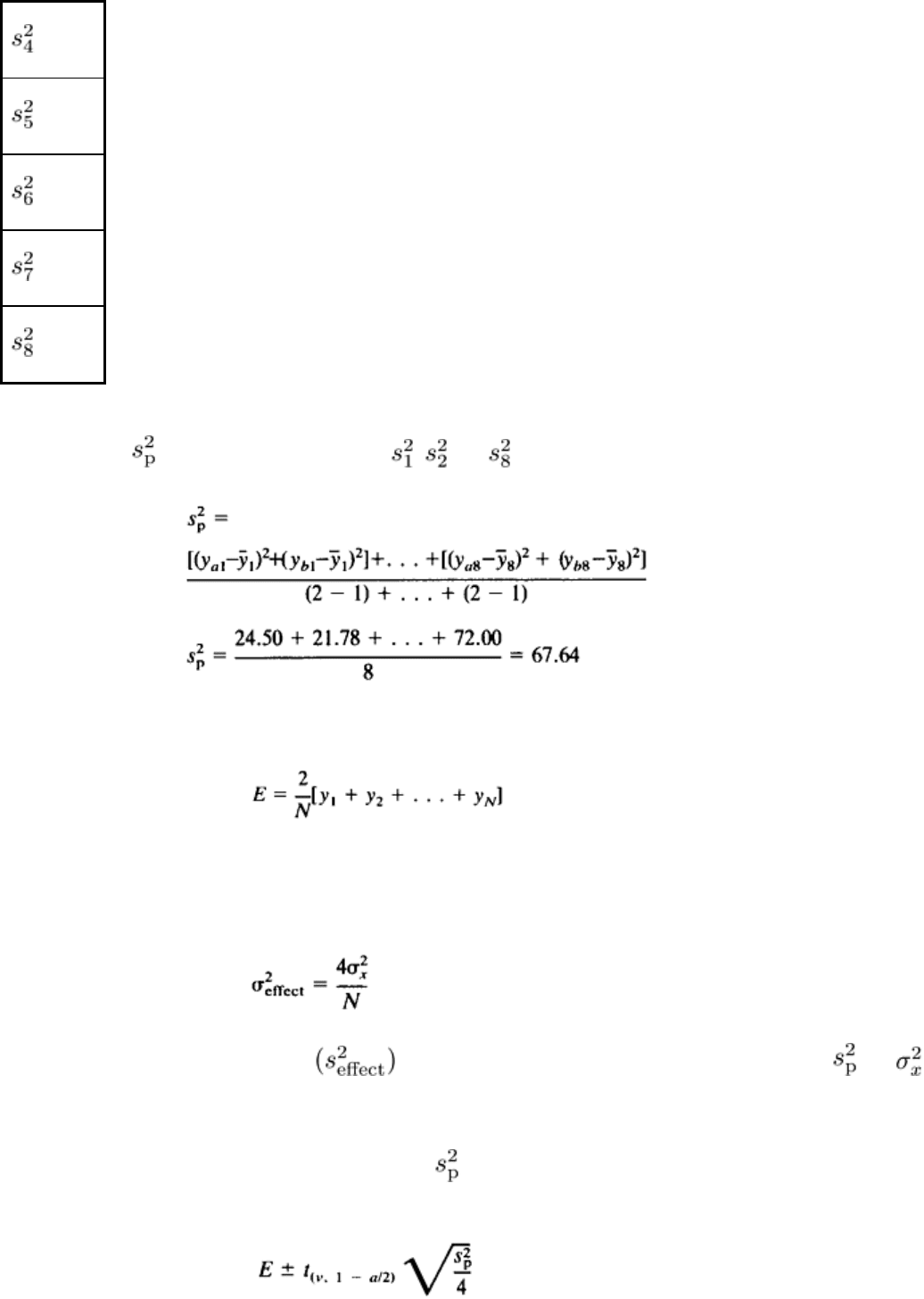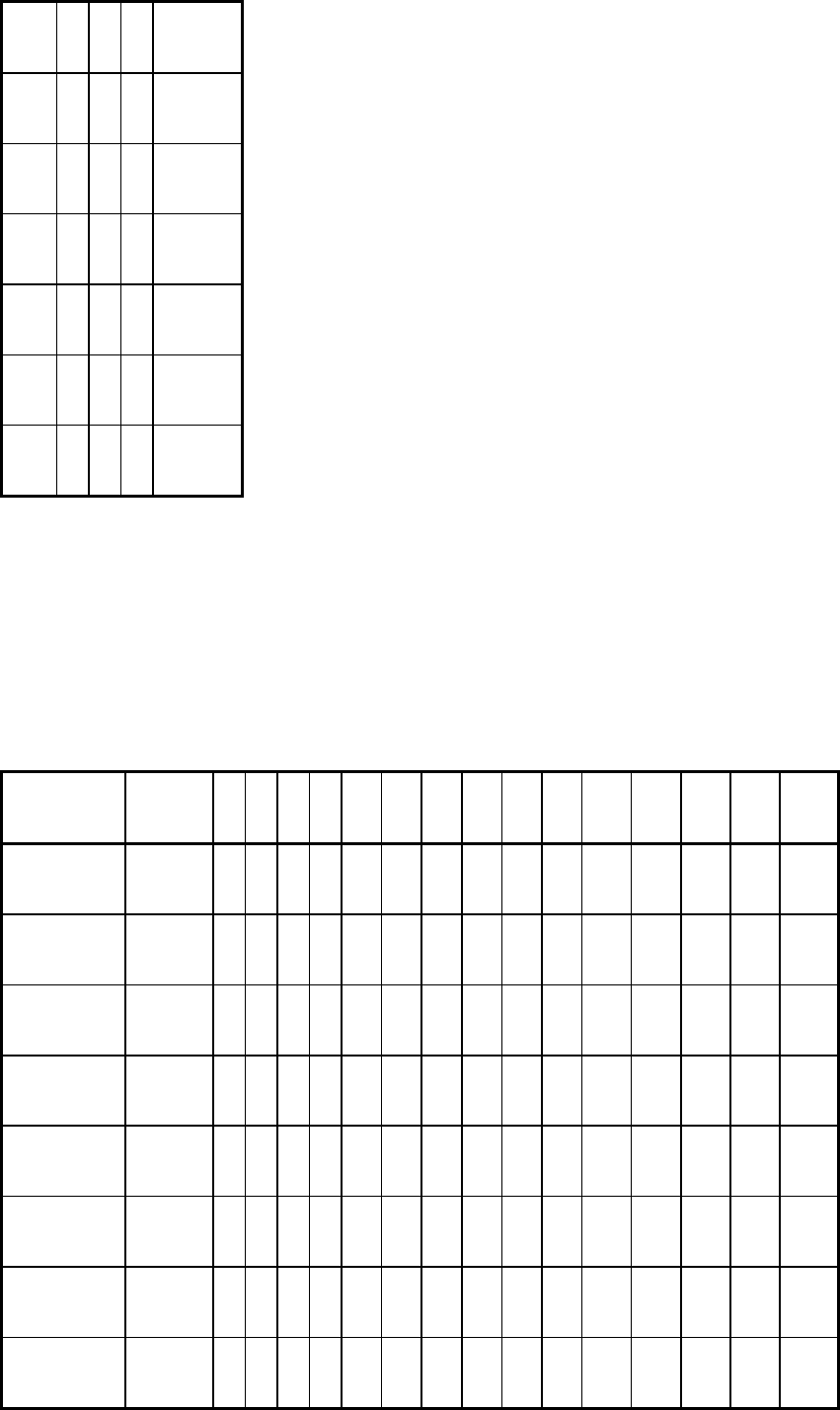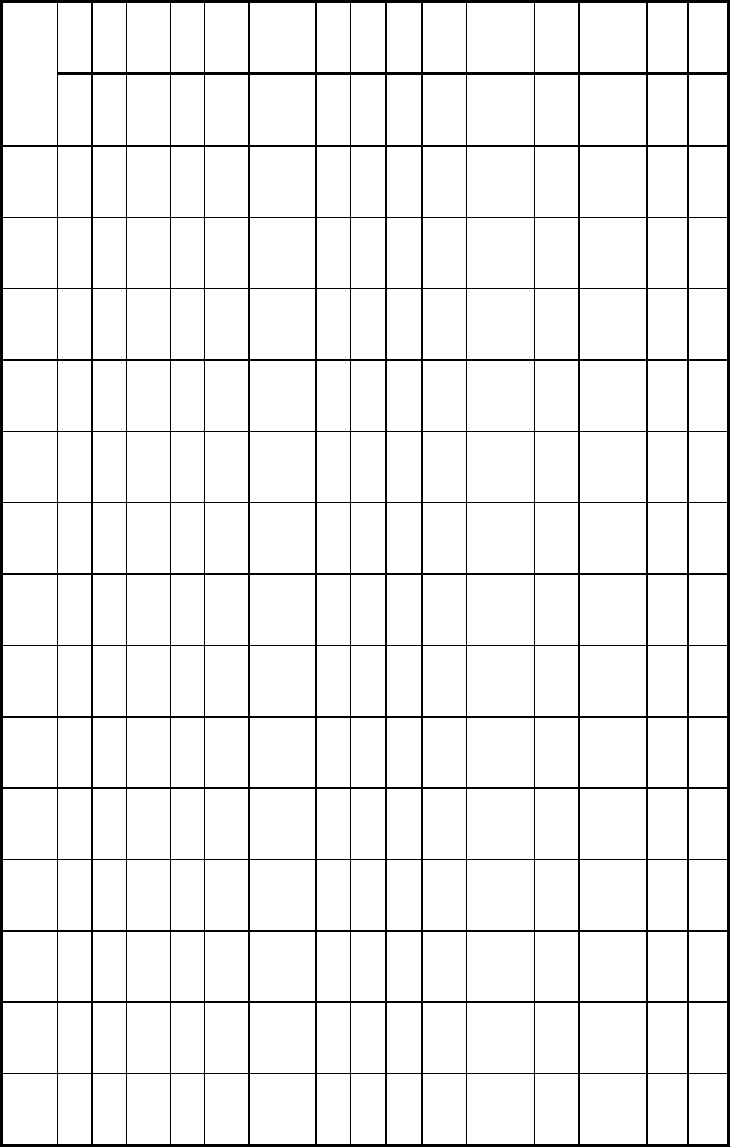ASM Metals HandBook Vol. 17 - Nondestructive Evaluation and Quality Control
Подождите немного. Документ загружается.


= 242.00
= 3.92
= 8.82
= 33.62
= 72.00
Because there is assumed to be a common variance for all 16 observations, an estimate for the variance is the pooled
sample variance , of the 8 estimated variances , , . . . . In this case:
(Eq 16)
In general, an effect is determined from:
(Eq 17)
where N is the total number of unique test/trial results.
In this general case, the variance of an effect is given by:
(Eq 18)
An estimate of the variance of an effect is obtained by substituting the pooled sample variance, , for .
A confidence interval for a certain parameter can be calculated on the basis of the sample statistic. Here the statistics of
interest are the average effects, E
1
, E
2
, E
3
, and the interactions, E
12
, E
13
, E
23
, and E
123
. Because the sample variances of the
average effects and interactions are all estimated by /4, the result, for 100(1 - a)% confidence intervals using the
Student's t-statistic, is:
(Eq 19)

where v = 8 is the degree of freedom and a = 0.05 is the level of significance. Therefore, the 95% confidence intervals for
each of the sample average effects are therefore:
Table 13 gives the seven statistics (E
1
, E
2
, E
3
, E
12
, E
13
, E
23
, and E
123
) together with their corresponding 95% confidence
intervals. From Table 13, it would appear that none of the estimated effects is important/significant.
Table 13 Calculation of 95% confidence levels for average effect and interaction statistics of steel rail b
ars
of Example 8
Average effects
95% confidence interval, psi
Ambient temperature (E
1
)
9150 ± 9480
Wind velocity (E
2
)
-5100 ± 9480
Bar size (E
3
)
850 ± 9480
Ambient temperature × wind velocity (E
12
)
0 ± 9480
Ambient temperature × bar size (E
13
)
-4650 ± 9480
Wind velocity × bar size (E
23
)
-100 ± 9480
Ambient temperature × wind velocity × bar size (E
123
)
4700 ± 9480
Unreplicated Factorial Designs. There are times when it is either not feasible or not desirable to include replication
in a two-level factorial design. In such cases, it is therefore not possible to obtain a direct estimate of the experimental
error; as a result, it becomes more difficult to assess the relative importance of the variable effects. There are, however, at
least two methods that can be employed to aid in the assessment of the relative importance of variable effects estimated
from the results of an unreplicated two-level factorial design. These two methods are:
• The use of normal probability plots of the effect estimates
• The use of higher-
order interaction effect estimates as a means to obtain an estimate of the experimental
error
These methods are discussed in Ref 7 and 25.
References cited in this section
7. G.E.P. Box and J.S. Hunter, The 2k-p Fractional Factorial Designs, Part I and Part II, Technometrics,
Vol 3,
1961
8. G.E.P. Box, W.G. Hunter, and J.S. Hunter, Statistics for Experimenters, John Wiley & Sons, 1978
23.
S.M. Wu, Analysis of Rail Steel Bar Welds By Two-Level Factorial Design, Weld. J. Research Supplement,

April 1964
24.
R.E. DeVor and T.H. Chang, Quality and Productivity Design and Improvement: Module 2, in
Statistical
Process Control, Ford Motor Company, Plastic Products Division, 1988
25.
R.E. DeVor and T.H. Chang, Statistical Methods for Quality and Productivity Design and Improvement, in
The Tool and Manufacturing Engineer's Handbook, Vol 4, Society of Manufacturing Engineers, 1987
Statistical Quality Design and Control
Richard E. DeVor, University of Illinois, Urbana-Champaign; Tsong-how Chang, University of Wisconsin, Milwaukee
Two-Level Fractional Factorial Designs
Although the class of two-level factorial designs appears to be an efficient way to deal simultaneously with several
factors, this efficiency quickly disappears as the number of variables to be studied grows. Because the two-level factorial
requires the consideration of all possible combinations of k variables at two levels each, a ten-variable experiment would
require 2
10
= 1024 tests.
In dealing with phenomena involving continuous variables, the relationship that describes the influence of the variables
on a response of interest often constitutes a relatively smooth response surface. When dealing with qualitative (discrete)
variables, it is usually the case that the responses are similar at different levels of such variables. Therefore, the higher-
order variable interactions are often very small or negligible in magnitude. In fact, interaction effects involving three
factors or more can be ignored for the purpose of screening out the much more important main effects and two-factor
interaction effects from a limited number of tests.
Experimentation with large numbers of variables generally arises out of uncertainty as to which variables have the
dominant influence on the response of interest. In the end, however, only a subset of all these variables will be proved to
be important. This phenomenon is referred to as the sparsity of variable effects (Ref 8). If this is the case, one should be
able to conduct fewer tests than required for the full factorial without much loss of relevant information.
Consequences of Fractionation
In the rail steel bar problem, three variables (ambient temperature, wind velocity, and bar size) were studied to determine
their possible effect on the ultimate tensile strength of the welded bars. A 2
3
full factorial design was run, and the three
main effects, three two-factor interaction effects and the one three-factor interaction effect could all be estimated
separately. Suppose now that the investigator had wished to consider a fourth variable, type of welding flux, but that the
full factorial, 2
4
= 16 tests, could not be considered. Rather, only 8 tests can be run. Is it possible to conduct an
experiment on 4 factors with only 8 tests, and if so, what useful information can be obtained from the results?
Based on the assumption about the negligible third and higher-order interaction effects, one could consider assigning the
column of plus and minus signs associated with the 123 interaction to be the fourth variable and estimate the average
main effect of variable 4 using this column. In using the 123 column to introduce a fourth variable into the experiment,
the new design matrix that defines the 8 tests to be conducted becomes:
Variables
Test
1
2
3
4 (123)
(a)
1 - - -
-

2 +
- -
+
3 - +
-
+
4 +
+
-
-
5 - - +
+
6 +
- +
-
7 - +
+
-
8 +
+
+
+
(a)
123 column replaced by
variable 4
Once the tests are conducted in accordance with the test recipes defined by the design matrix, the calculation matrix is
determined to provide for the estimation of the interaction effects. By expanding the design matrix above, Table 14
provides the calculation matrix obtained by forming all possible products of columns 1 through 4.
Table 14 Calculation matrix obtained by expanding the design matrix
Test number
Average
1
2
3
4
12
13
14
23
24
34
123
124
134
234
1234
1 + - - - - + + + + + + - - - -
+
2 + +
- - +
- - + + - - + - - +
+
3 + - +
- +
- + - - + - + - + -
+
4 + +
+
- - + - - - - + - - + +
+
5 + - - +
+
+ - - - - + + + - -
+
6 + +
- +
- - + - - + - - + - +
+
7 + - +
+
- - - + + - - - + + -
+
8 + +
+
+
+
+ + + + + + + + + + +

Examination of the calculation matrix in Table 14 reveals that many of the columns are identical. In particular, of the 16
columns, only 8 are unique; each unique column appears twice. The following pairs of variable effects are represented in
the calculation matrix by the same column of plus and minus signs:
1 and 234
2 and 134
3 and 124
4 and 123
12 and 34
13 and 24
23 and 14
Ave and 1234
What does all this mean? For example, when the 12 column is multiplied by the data, summed, and divided by 4, is the
result an estimate of the two-factor interaction 12? Or the two-factor interaction 34? Or both? The interactions 12 and 34
are said to be confounded or confused. They are aliases of the unique column of plus and minus signs defined by (+ - - +
+ - - +). Use of this column for effect estimation produces a number (estimate) that is actually the combined total of the
two-factor interaction effects 12 and 34. Similarly, 1 and 234 are confounded effects, 2 and 134 are confounded effects,
and so on. It seems that the innocent act of using the 123 column to introduce a fourth variable into a 2
3
full factorial
scheme has created a lot of confounding among the variable effects, but if all the three-factor interactions are negligible,
one obtains clear estimates of all 4 main effects from only 8 tests.
The 2
k-p
Fractional Factorial Designs. The four-variable, eight-test, two-level experiment discussed thus far is
referred to as a two-level fractional factorial design because it considers only a fraction of the tests defined by the full
factorial. In this case, a one-half fraction design has been created. It is commonly referred to as a 2
4-1
fractional factorial
design. It is a member of the general class of 2
k-p
fractional factorial designs. In these designs, the following factors must
be considered:
• k variables are examined in 2
k-p
tests
• Require that p of the variables be introduced into the full factorial in k-p variables
• Assign them to interaction effects in the first k-p variabl
es. This assignment is done through the use of
relationships known as generators (Ref 7, 8)
• These generators can then be used to establish the defining relationship (Ref 7, 8
), which completely
reveals the confounding/alias structure of the experimental design
Resolution of Two-Level Fractional Factorial Designs. As discussed previously, the introduction of additional
variables into full two-level factorials gives rise to confounding or aliasing of variable effects. It would be desirable to
make this introduction in such a way as to confound low-order effects (main effects and two-factor interactions)--not with

each other but with higher-order interactions. Then, under the assumption that third and higher-order interactions can be
neglected, the low-order effects become, in a sense, unconfounded by this assumption.
To illustrate, consider the study of 5 variables in just 16 tests (the full factorial would require 2
5
= 32 tests). One
additional variable--the fifth variable--must be introduced into a 2
4
= 16 run base design. Any of the interactions in the
first 4 variables could be used for this purpose: 12, 13, 14, 23, 24, 34, 123, 124, 134, 234, 1234. If any one of the two-
factor interactions are used, for example, 5 = 12, then the design generator becomes I = 125, which is also the defining
relationship. Therefore, at least some of the main effects will be confounded with two-factor interactions, namely, 1 = 25,
2 = 15, 5 = 12.
Selecting Preferred Generators. If any one of the three-factor interactions is used to introduce the fifth variable, the
situation is greatly improved, at least for the estimation of main effects. For example, if 5 =123, then I = 1235 is the
generator and defining relationship; therefore, some main effects are confounded with, at worst, three-factor interactions,
while two-factor interactions are confounded with each other, for example:
1 = 235
2 = 135
3 = 125
5 = 123
12 = 35
13 = 25
23 = 15
If the four-factor interaction in the first 4 variables is used to introduce the fifth variable, an even more desirable result is
obtained (the best under these circumstances): 5 = 1234. The generator and defining relationship is I = 12345. Therefore:
1 = 2345
2 = 1345
3 = 1245
4 = 1235

5 = 1234
12 = 345
13 = 245
14 = 235
15 = 234
23 = 145
24 = 135
25 = 134
34 = 125
35 = 124
45 = 123
In this last case, all main effects are confounded with four-factor interactions, and all two-factor interactions are
confounded with three-factor interactions.
Concept of Resolution. The varying confounding structures produced by using different orders of variable
interactions to introduce the fifth variable in the example above are described by the concept of the resolution of
fractional factorial designs. The resolution of a two-level fractional factorial design is defined to be equal to the number
of letters (numbers) in the shortest-length word (term) in the defining relationship, excluding I. If the defining relationship
of a certain design is I = 124 = 135 = 2345, then the design is of Resolution III. If the defining relation of a certain design
is I = 1235 = 2346 = 1456, then the design is of Resolution IV. The last design examined above, which had the defining
relationship I = 12345, is a Resolution V design. These concepts can be summarized as follows:
• If a design is of Resolution III, this means that at least some main effects are confounded with two-
factor interactions
• If a design is of Resolution IV, this means that at least some main effects are confounded with three-
factor interactions, while at least some two-factor interactions are confounded with other two-
factor
interactions
• If a design is of Resolution V, this means that at least some main effects are confounded with four-
factor interactions, and some two-factor interactions are confounded with three-factor interactions
Example 9: Design Resolution/Selection of Generators.
A 2
6-2
fractional factorial design is set up by introducing variables 5 and 6 via 5 = 123, 6 = 1234. What is the resolution of
this design?
The design generators are I = 1235 = 12346, with the defining relationship I = 1235 = 12346 = 456. Therefore, the design
is of Resolution III.
What would the resolution be if the generators were 5 = 123 and 6 = 124? Because the defining relationship is I = 1235 =
1246 = 3456, the design is of Resolution IV. It is clear that the selection of the proper design generators is very important.
Additional Observations on Design Resolutions. From the above discussion on design resolution, several
observations can be made:
• Higher-resolution designs seem more desirable because they provide the opportunity for low-
order
effect estimates to be determined in an unconfounded state, assuming higher-order interaction effe
cts
can be neglected
•
The more variables considered in a fixed number of tests, the lower the resolution of the design becomes
•
There is a limit to the number of variables that can be considered in a fixed number of tests while
maintaining a prespecified resolution requirement
• No more than (n - 1) variables can be examined in n tests (n
is a power of 2, for example, 4, 8, 16, 32, . .
.) to maintain a design resolution of at least III. Such designs are commonly referred to as saturated
designs. Examples are 2
3-1
, 2
7-4
, 2
15-11
, 2
31-26
. For saturated designs, all interactions in the base design
variables are used to introduce additional variables
Importance of Sequential Experimentation
In the early stages of an investigation, it often seems that many variables are of potential importance. A project group or
task force can draw up a list of 5 to 15 or more variables. In the final analysis, perhaps only 2 or 3 of these variables will
prove to be important. The problem is, Which ones? The first task at hand is to conduct some experiments that will
quickly reduce the number of variables under study to the few seemingly important ones that will then be the focus of
further experimentation. For this screening task, two-level fractional factorial designs constitute a powerful and efficient
tool. If the investigator attempts to get his arms around the entire problem by designing one comprehensive experiment,
the resource requirements will probably be extensive, and the final results of the experiment may be inconclusive because
of poor selection of variable levels and/or a poorly controlled experimental environment precipitated by a large
experiment.
It would be wise to take a sequential approach, building up knowledge more gradually through a series of related
experiments. In this regard, two-level fractional factorial designs serve as useful building blocks in a course of sequential
experimentation. This notion is important to ensure that a lack of knowledge early in an investigation will not lead to the
waste of experiment resources--for example, inappropriate variables or variable levels chosen in the context of one large
experiment. It is possible to identify families of experiments that combine or piece together well. A key point here is that
these related experiments can provide several different alternatives for a second experiment, depending on the results and
inferences drawn from the first experiment. The sequential assembly aspect of related experiments is discussed below.
Example 10: Notion of Families of Fractional Factorials.
All 16 one-sixteenth fractions of the 2
7
factorial are related through the generators I = ±124, I = ±135, I = ±236, I =
±1237. The terms remain the same, only the signs are changed for different fractions. The original design (all + signs on
the generators) is called the principal fraction. The remaining 15 are the alternate fractions.
The key point is that, depending on the interpretation of the results of the principal fraction, any one of several other
alternate fractions can be chosen to achieve a particular result when the two fractions are combined. A general strategy
used in running successive experimental designs is to choose judiciously among the members of a given family of
fractional factorials.
Clearly, given the principal fraction, several alternatives are available among the remaining alternate fractions, each
providing a different set of information/effect estimates from the combined design. Table 15 provides some relevant
information concerning the family of fractional factorials associated with a seven-variable experiment using eight-test
designs.

Table 15 family of fractional factorials
Fraction
Generators
When combined with principal
fraction gives:
Principal
I = 124 I = 135 I = 236 I = 1237
. . .
A1 I = -124 I = -135 I = -236 I = -1237
All main effects
A2
I = -124 I = - 135 I = 236 I = -1237
1, 12, 13, 14, 15, 16, 17
A3
I = -124 I = 135 I = -236 I = -1237
2, 12, 23, 24, 25, 26, 27
A4
I = 124 I = -135 I = -236 I = -1237
3, 13, 23, 34, 35, 36, 37
A5
I = -124 I = 135 I = 236 I = 1237
4, 14, 24, 34, 45, 46, 47
A6
I = 124 I = -135 I = 236 I = 1237
5, 15, 25, 35, 45, 56, 57
A7
I = 124 I = 135 I = -236 I = 1237
6, 16, 26, 36, 46, 56, 67
A8
I = 124 I = 135 I = 236 I = -1237 7, 17, 27, 37, 47, 57, 67
Orthogonal Arrays
The theory of fractional factorial designs was first worked out by Finney (Ref 26) and Rao (Ref 27). Many highly
fractionated designs were introduced by Tippett (Ref 28), Plackett and Burman (Ref 29), and others. Some of these were
referred to as magic squares and orthogonal arrays. Two-level and three-level fractional factorial designs gained
widespread attention and industrial application, beginning in the 1950s. Box and Hunter (Ref 7) provided much useful
guidance to the practitioner in the adroit use of these experimental design structures.
In the late 1970s, the use of orthogonal arrays for quality design and improvement by Taguchi (Ref 4) and others gained
widespread acceptance in industry. This has led to considerable discussion concerning the relative merits of these designs
and the methods of design selection vis-à-vis the methodology of the more general class of fractional factorial designs. In
particular, it is important to examine the philosophical framework and interpretation of these similar (often identical)
design structures.
Issue of Confounding. To many, the most significant property of the designs is orthogonality, that is, the ability to
separate out the individual effects of several variables on a response of interest. The term orthogonal arrays as used by
Taguchi implies having this property of orthogonality or producing effects that are not confounded. In fact, whenever
anything less than a full factorial is under consideration, confounding or mixing of effects is present by definition. Such
confounding can only be removed by assumptions made about the physical system and confirmed through some analyses
of the results.
Similarly, when two-level factorials are fractionated, the ability to determine all the interactions among a set of factors is
lost. However, judicious fractionation leads to the ability to obtain knowledge on low-order interactions under the
assumption that higher-order interactions are of negligible importance. Because the orthogonal arrays, as applied to
Taguchi methods, are highly fractionated factorial designs, the information these arrays produce is a function of two
elements: the nature of their confounding patterns and the assumptions made about the physical system they are applied

to. Often, Taguchi's use of linear graphs for design selection fails to produce the highest possible degree of resolution, as
the following example will illustrate.
Example 11: Examination of the Use of an L
16
(2
15
) Orthogonal Array
(Ref 4). The notation for various orthogonal arrays by Taguchi and Wu is generally of the following form for designs
without mixing levels L
n
(r
m
), where n is number of tests, r is number of levels of each factor, and m is the maximum
number of factors, including selected interactions, that the design can study. For example, L
16
(2
15
) refers to a design with
16 tests to study up to 15 two-level factors and/or interactions. An L
16
(2
15
) orthogonal array is given in Table 16.
Table 16 An L
16
(2
15
) orthogonal array
F
A
e
(a)
B
e
(a)
A × B
E
C
H
e
(a)
B × D
e
(a)
A × D
G D Test
1
2
3 4
5 6 7
8 9 10
11 12
13 14
15
1 1
1
1 1
1 1 1
1 1 1 1 1 1
2 1
1
1 1
1 1 1
2 2 2 2 2 2 2
2
3 1
1
1 2
2 2 2
1 1 1 1 2 2 2
2
4 1
1
1 2
2 2 2
2 2 2 2 1 1 1
1
5 1
2
2 1
1 2 2
1 1 2 2 1 1 2
2
6 1
2
2 1
1 2 2
2 2 1 1 2 2 1
1
7 1
2
2 2
2 1 1
1 1 2 2 2 2 1
1
8 1
2
2 2
2 1 1
2 2 1 1 1 1 2
2
9 2
1
2 1
2 1 2
1 2 1 2 1 2 1
2
10 2
1
2 1
2 1 2
2 1 2 1 2 1 2
1
11 2
1
2 2
1 2 1
1 2 1 2 2 1 2
1
12 2
1
2 2
1 2 1
2 1 2 1 1 2 1
2
13 2
2
1 1
2 2 1
1 2 2 1 1 2 2
1
14 2
2
1 1
2 2 1
2 1 1 2 2 1 1
2
